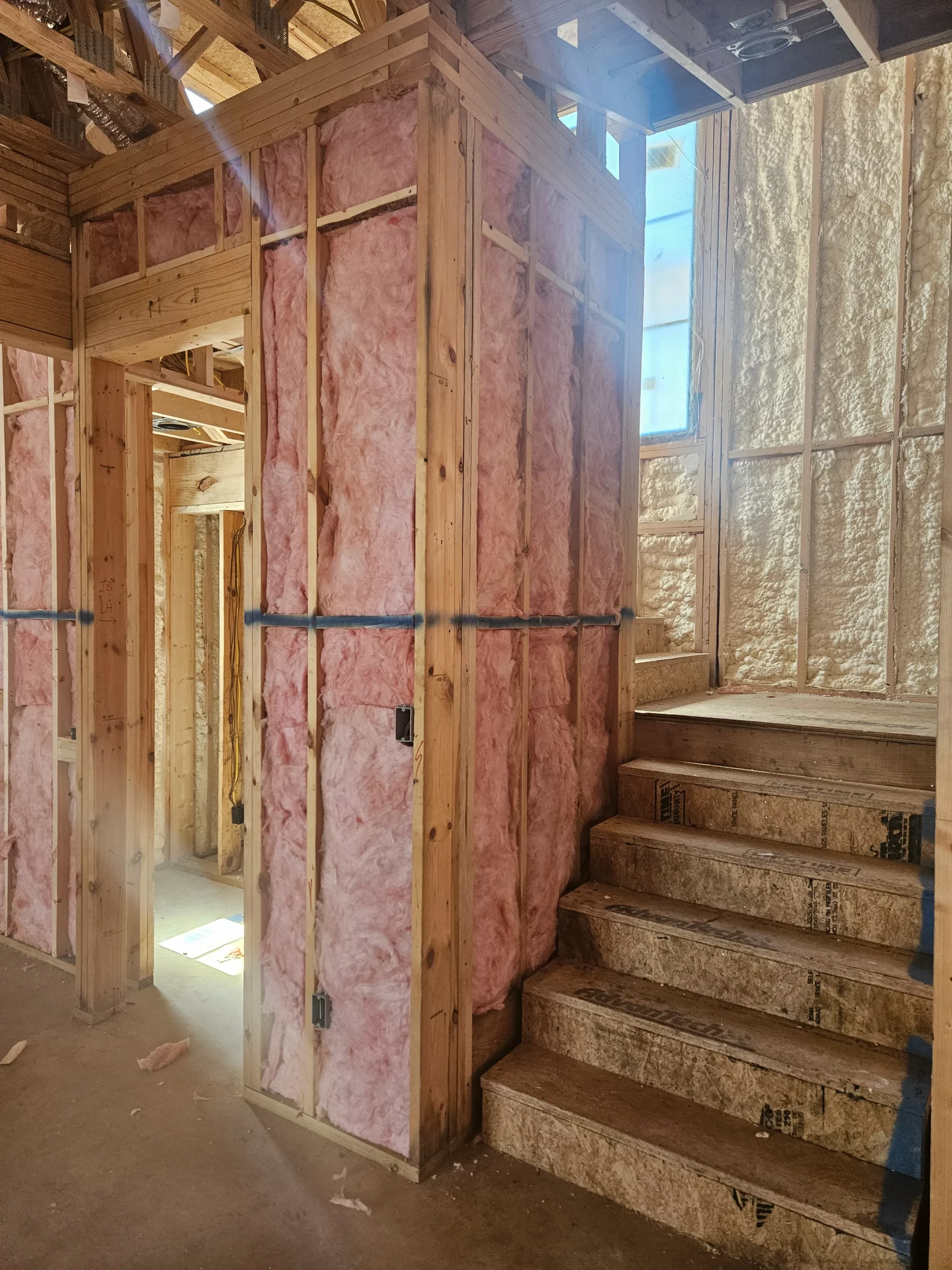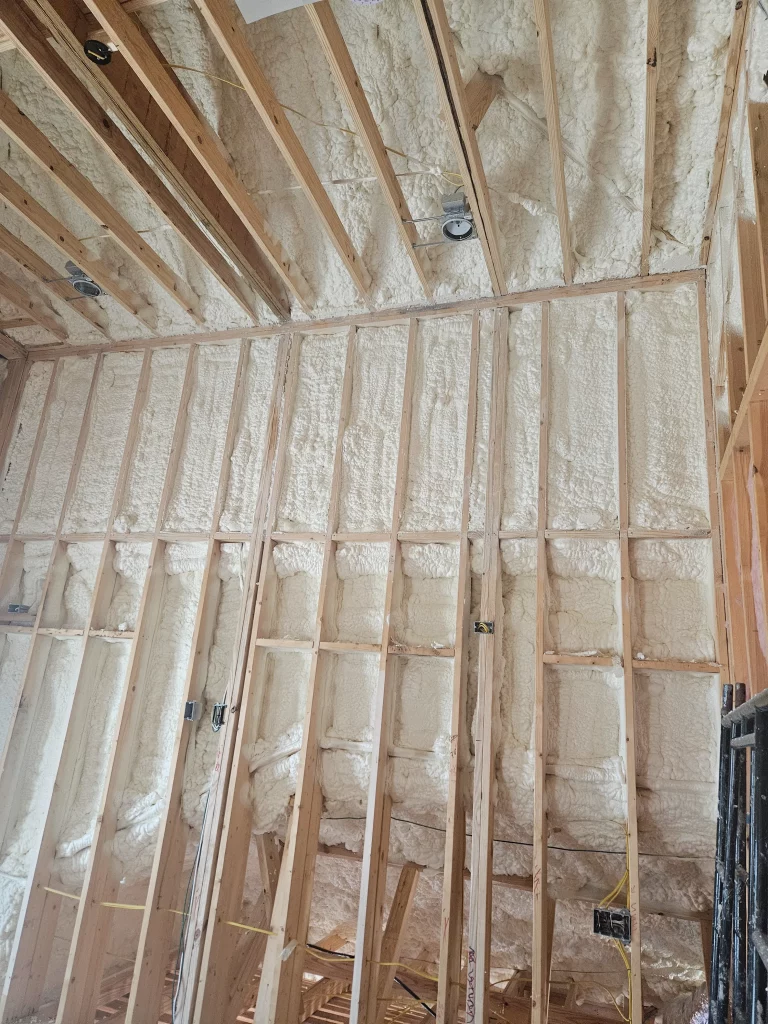
Spray foam insulation expands through a chemical reaction when two liquid components mix on site. Installers combine a polyol resin with an isocyanate hardener, which triggers the creation of polyurethane foam. This reaction releases gas that causes the material to grow rapidly, often up to 100 times its liquid volume, sealing cracks, crevices, and irregular spaces in walls, attics, and crawl spaces. In Georgetown, TX, this process helps homeowners combat the area’s extreme temperature swings.
This article breaks down the science step by step, covering practical applications in local homes and insights from hands-on installations by Spray Foam Tech across Central Texas. You’ll gain a clear understanding of how the expansion works and why it matters for energy efficiency.
The foundation of spray foam insulation lies in its two-part formula. One part contains polyether polyols, catalysts, and blowing agents. The other holds polymeric isocyanates. When a spray gun mixes these liquids, they react almost instantly.
Heat builds up during the reaction, known as an exothermic process. This drives the foam to rise and harden. Closed-cell spray foam uses hydrofluorocarbons (HFCs) as blowing agents, creating dense bubbles that trap gas for better insulation. Open-cell versions rely on water or CO2, resulting in a softer, air-filled structure that still expands effectively.
In Georgetown’s humid subtropical climate, installers adjust mixing ratios to account for high moisture levels. Excess humidity can affect expansion, so professionals monitor conditions closely.
Expansion happens in distinct phases, each critical for full coverage.
First, the liquids combine and begin to cream, turning creamy as the reaction starts. Within seconds, the mixture rises, expanding to fill voids. It gels next, gaining structure, before curing into a solid foam. The whole process takes about 30 seconds to a minute, depending on temperature and humidity.
During rise, the foam adheres to surfaces and conforms to shapes, unlike rigid insulation boards. This adaptability seals gaps as small as 1/8 inch, preventing air leaks that drive up heating and cooling costs.
A study from the U.S. Department of Energy shows that air sealing with spray foam can cut energy use by 10 to 20 percent in homes. Georgetown residents often see similar results amid the region’s 100-degree summers and occasional freezes.
| Stage | Description | Time Frame | Key Effect |
|---|---|---|---|
| Mixing | Liquids blend in gun | Instant | Reaction initiates |
| Creaming | Mixture turns viscous | 2-5 seconds | Initial gas formation |
| Rising | Foam expands rapidly | 5-20 seconds | Fills gaps and crevices |
| Gelling | Structure firms up | 20-30 seconds | Adhesion strengthens |
| Curing | Full hardening | 1-24 hours | Insulation properties set |
This table outlines the timeline based on standard conditions. In Georgetown’s variable weather, installers extend curing time during rainy spells to ensure proper set.
Bonus Tip: Always apply foam in layers no thicker than 2-3 inches at a time. Thicker applications can lead to uneven expansion and trapped heat, reducing overall performance.
Gaps in home structures allow conditioned air to escape, forcing HVAC systems to work harder. Spray foam’s expansion creates an airtight barrier, reducing infiltration by up to 75 percent according to tests from Oak Ridge National Laboratory.
The material’s low viscosity before expansion lets it flow into tight spots, like around pipes or electrical outlets. Once expanded, it locks in place, resisting settling over time. For Georgetown homes built in the 1980s and 1990s, this addresses common issues from settling foundations and wood framing shifts.
Market data indicates that Texas homes with spray foam insulation save an average of $300 annually on utility bills. The state’s hot climate amplifies these savings, as cooling accounts for nearly 60 percent of energy use.

Georgetown experiences hot, humid summers and mild winters with occasional ice storms. Spray foam’s expansion handles these conditions well by creating a moisture-resistant seal. Closed-cell foam, in particular, acts as a vapor barrier, preventing condensation in attics.
Local building codes require R-30 to R-49 insulation in attics, and spray foam meets these standards while filling irregular joist spaces. Installers note that the area’s clay soils cause more foundation movement than in sandy regions, making gap-filling essential.
Data from the Texas State Energy Conservation Office reveals that Central Texas homes lose 25 percent of energy through unsealed gaps. Effective insulation like spray foam directly counters this. With these climate challenges in mind, homeowners should carefully assess their options before proceeding.
Bonus Tip: Test ambient temperature before application; ideal range is 60-80°F. Below that, expansion slows, leaving voids. In Georgetown’s cooler mornings, waiting until mid-day often yields better results.
Homeowners in Georgetown should evaluate several factors before choosing spray foam.
Assess current insulation levels with a simple energy audit. Older homes may have outdated fiberglass that has compressed, reducing effectiveness. Consider the structure’s size; larger attics require more material but offer greater returns.
Budget plays a role, as upfront costs range from $1 to $3 per square foot depending on type. Weigh long-term savings against initial investment. Check for health concerns; some foams off-gas VOCs during curing, so ensure good ventilation.
Review local permits; Williamson County requires inspections for major retrofits. Finally, think about DIY versus professional application. The precision needed for even expansion favors experts.
Bonus Tip: Inspect for pests before insulating. Termites common in Texas can hide in gaps, and foam expansion might seal them in, complicating future treatments.
When applied correctly, the force stays below 10 psi, safe for most framing.
Quality foams shrink less than 1 percent after curing.
Closed-cell foam repels water, lowering mold risk compared to fibrous insulations.
It matches the pace of professional spraying to avoid drips.
Higher temperatures speed up the reaction, leading to faster rise but potential over-expansion if not controlled. In Georgetown’s summer heat, pros lower pressure to manage this. Cooler weather slows it, requiring warmer materials for full fill.
Yes, it flows past wires and outlets, then expands to seal without compressing them. Electricians often coordinate with insulation crews to avoid hazards. This ensures code compliance in Texas homes.
Uneven expansion leaves voids, reducing R-value. Causes include improper mixing or surface prep. Prepping dusty or wet areas prevents this, maintaining even coverage.
Both fill gaps well, but closed-cell expands denser and offers higher R-value per inch. Open-cell suits soundproofing needs. Choice depends on space and goals; in Georgetown, closed-cell handles moisture better.
Surface sets in minutes, but full cure takes 24 hours. Avoid disturbing areas during this time to prevent deformation. In humid conditions, extend to 48 hours for safety.
Spray foam expands via a precise chemical mix that fills every gap, improving home efficiency in Georgetown’s demanding climate. Key points include the rapid reaction phases, climate adaptations, and decision factors like audits and budgets. Homeowners benefit from understanding these elements to choose wisely.
Evaluate personal home setup, energy bills, and local weather patterns. Align choices with long-term comfort and cost goals for the best outcomes.
Georgetown homeowners facing high energy costs from gaps can explore spray foam options. Spray Foam Tech offers insights based on local applications. Reach out via email at oldworldtx@hotmail.com or call (737) 777-9590 to discuss specifics. This step helps tailor solutions to individual needs without commitment.
Read more and discover the latest enhancements to Spray Foam Tech’s insulation services and how they benefit homeowners in Georgetown.